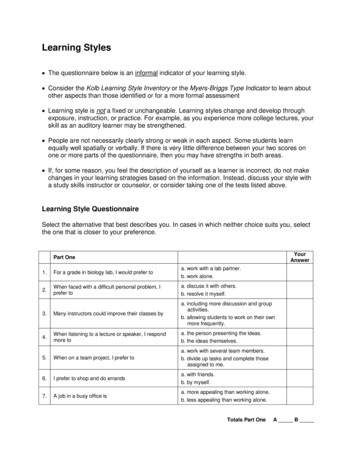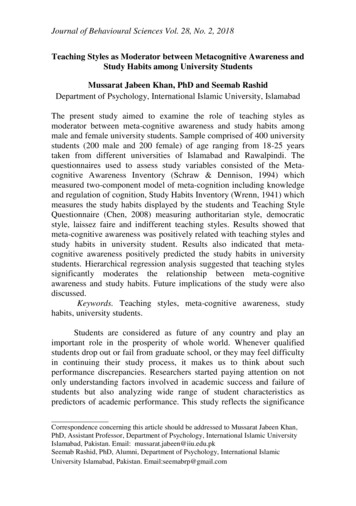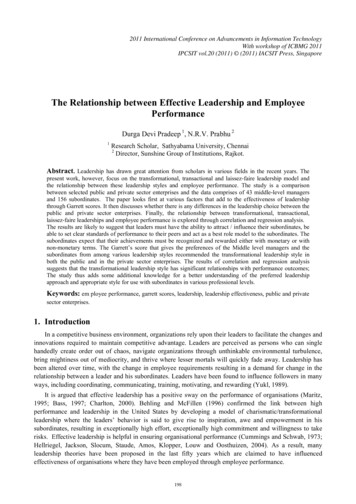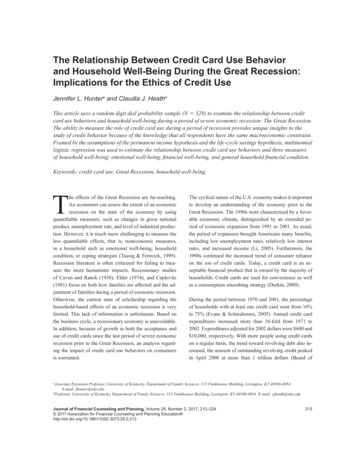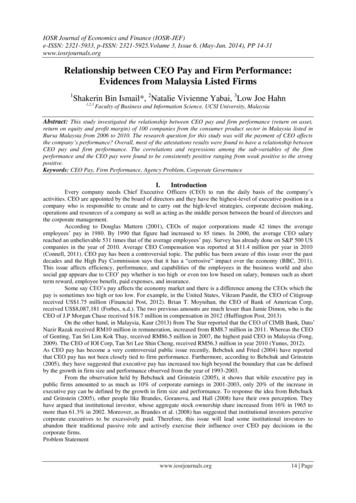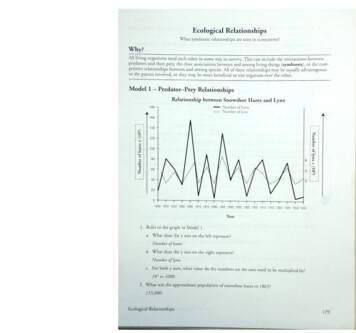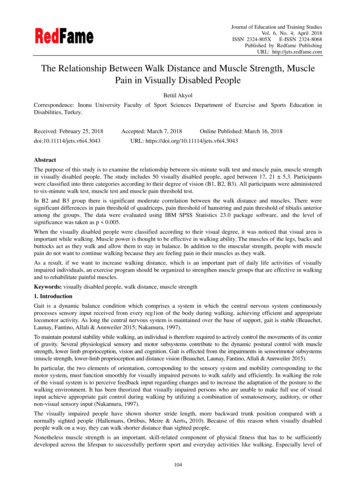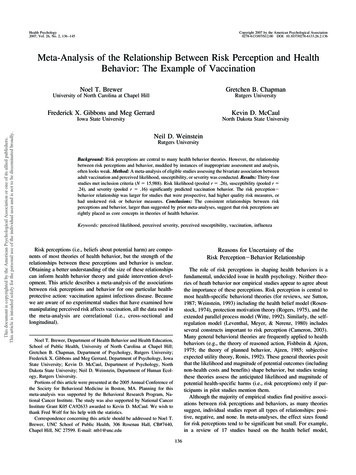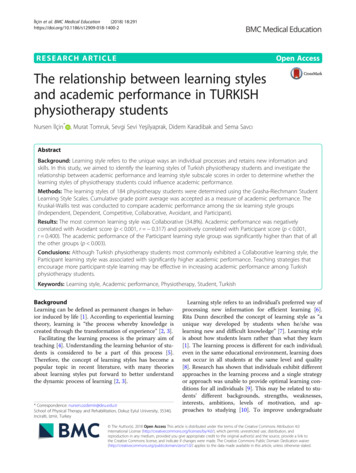
Transcription
İlçin et al. BMC Medical Education(2018) EARCH ARTICLEOpen AccessThe relationship between learning stylesand academic performance in TURKISHphysiotherapy studentsNursen İlçin* , Murat Tomruk, Sevgi Sevi Yeşilyaprak, Didem Karadibak and Sema SavcıAbstractBackground: Learning style refers to the unique ways an individual processes and retains new information andskills. In this study, we aimed to identify the learning styles of Turkish physiotherapy students and investigate therelationship between academic performance and learning style subscale scores in order to determine whether thelearning styles of physiotherapy students could influence academic performance.Methods: The learning styles of 184 physiotherapy students were determined using the Grasha-Riechmann StudentLearning Style Scales. Cumulative grade point average was accepted as a measure of academic performance. TheKruskal-Wallis test was conducted to compare academic performance among the six learning style groups(Independent, Dependent, Competitive, Collaborative, Avoidant, and Participant).Results: The most common learning style was Collaborative (34.8%). Academic performance was negativelycorrelated with Avoidant score (p 0.001, r 0.317) and positively correlated with Participant score (p 0.001,r 0.400). The academic performance of the Participant learning style group was significantly higher than that of allthe other groups (p 0.003).Conclusions: Although Turkish physiotherapy students most commonly exhibited a Collaborative learning style, theParticipant learning style was associated with significantly higher academic performance. Teaching strategies thatencourage more participant-style learning may be effective in increasing academic performance among Turkishphysiotherapy students.Keywords: Learning style, Academic performance, Physiotherapy, Student, TurkishBackgroundLearning can be defined as permanent changes in behavior induced by life [1]. According to experiential learningtheory, learning is “the process whereby knowledge iscreated through the transformation of experience” [2, 3].Facilitating the learning process is the primary aim ofteaching [4]. Understanding the learning behavior of students is considered to be a part of this process [5].Therefore, the concept of learning styles has become apopular topic in recent literature, with many theoriesabout learning styles put forward to better understandthe dynamic process of learning [2, 3].* Correspondence: nursen.ozdemir@deu.edu.trSchool of Physical Therapy and Rehabilitation, Dokuz Eylul University, 35340,Inciralti, Izmir, TurkeyLearning style refers to an individual’s preferred way ofprocessing new information for efficient learning [6].Rita Dunn described the concept of learning style as “aunique way developed by students when he/she waslearning new and difficult knowledge” [7]. Learning styleis about how students learn rather than what they learn[1]. The learning process is different for each individual;even in the same educational environment, learning doesnot occur in all students at the same level and quality[8]. Research has shown that individuals exhibit differentapproaches in the learning process and a single strategyor approach was unable to provide optimal learning conditions for all individuals [9]. This may be related to students’ different backgrounds, strengths, weaknesses,interests, ambitions, levels of motivation, and approaches to studying [10]. To improve undergraduate The Author(s). 2018 Open Access This article is distributed under the terms of the Creative Commons Attribution 4.0International License (http://creativecommons.org/licenses/by/4.0/), which permits unrestricted use, distribution, andreproduction in any medium, provided you give appropriate credit to the original author(s) and the source, provide a link tothe Creative Commons license, and indicate if changes were made. The Creative Commons Public Domain Dedication o/1.0/) applies to the data made available in this article, unless otherwise stated.
İlçin et al. BMC Medical Education(2018) 18:291education, educators should become more aware ofthese diverse approaches [11]. Learning styles may beuseful to help students and educators understand howto improve the way they learn and teach, respectively.Determining students’ learning styles provides information about their specific preferences. Understandinglearning styles can make it easier to create, modify, anddevelop more efficient curriculum and educational programs. It can also encourage students’ participation inthese programs and motivate them to gain professionalknowledge [9]. Therefore, determining learning style isquite valuable in order to achieve more effective learning. Researching learning styles provides data on howstudents learn and find answers to questions [5].Considering the potential problems encountered in theundergraduate education of physiotherapists, determiningthe learning style of physiotherapy students may enablethe development of strategies to improve the learningprocess [12]. Studies on learning styles in the field ofphysiotherapy have mostly been conducted in developedcountries such as Canada and Australia [13, 14]. A studyconducted in Australia examined the learning styles ofphysiotherapy, occupational therapy, and speech pathology students. The results of this study suggest that optimal learning environment should also be taken intoconsideration while researching how students learn. Theauthors also stated that future research was needed to investigate correlations between learning styles, instructional methods, and the academic performance ofstudents in the health professions [14].To the best of our knowledge, there are no prior publications in the literature that report Turkish physiotherapystudents’ learning styles. Furthermore, previous studiesmostly used Kolb’s Learning Style Inventory (LSI),Marshall & Merritts’ LSI, or Honey & Mumford’sLearning Style Questionnaire (LSQ) to assess learningstyles [5, 13, 15–18]. Some of these studies also suggestedthat learning behavior and styles should be investigatedusing different inventories [5]. Moreover, a scale that wasindicated as valid and reliable for Turkish population wasneeded to accurately determine the learning styles ofTurkish physiotherapy students. Therefore, we opted touse the Grascha-Riechmann Learning Style Scales(GRLSS) to assess the learning styles of physiotherapy students, which will be a first in the literature.Learning style preferences are influential in learningand academic achievement, and may explain how students learn [19]. Previous studies have demonstrated aclose association between learning style and academicperformance [20, 21]. Learning styles have been identified as predictors of academic performance and guidesfor curriculum design. The aim of this study was to determine whether learning style preferences of physiotherapy students could affect academic performance byPage 2 of 8identifying the learning styles of Turkish physiotherapystudents and assessing the relationship between theselearning styles and the students’ academic performance.Since physiotherapy education mainly consists of practicelessons and clinical practice and mostly requires activestudent participation, we hypothesized that physiotherapystudents with a Collaborative learning style according tothe GRLSS would have higher academic performance.MethodsA cross-sectional survey design using a conveniencesample was used. The study population consisted of 488physiotherapy students who were officially registered forthe 2013–2014 academic year in Dokuz Eylul University(DEU) School of Physical Therapy and Rehabilitation. Aminimum sample size of 68 participants was calculatedwith 95% confidence interval and 80% power by using“Epi Info Statcalc Version 6”. Inclusion criteria were (i)age 17 years, (ii) official registration in DEU School ofPhysical Therapy and Rehabilitation for the 2013–2014academic year, (iii) being a first-, second-, third-, orfourth-year undergraduate student of physiotherapy, (iv)ability to read, write, and understand Turkish, and (v)being willing and able to participate in the study. Exclusion criteria were (i) unwilling to participate in the study,(ii) inability to read, write, and understand Turkish. Thequestionnaire was distributed to the physiotherapy students in a classroom setting during the final exam weekof the academic year. Due to the absence of participantswho did not attend final exams and were not actively attending classes (non-attendance students), questionnaires were distributed to 217 students in total.184 physiotherapy students with a mean SD age of21.52 1.75 years participated in the study. Participantswere informed verbally and in writing about the purposeof the study and the survey that would be implemented.A research assistant was available in the classroom toprovide assistance if required. Demographic characteristics (age, gender, undergraduate year) comprised the firstsection of the questionnaire, followed by the GRLSS toassess learning style.Cumulative grade point average (CGPA) shown on thestudents’ transcripts was used as the measure of academicperformance. The students’ CGPAs at the end of the2013–2014 academic year were obtained from the recordsheld in the student affairs unit of the DEU School of Physical Therapy and Rehabilitation. CGPA was derived bymultiplying the grade point (out of 100) with the creditunits for each module or course and then dividing thetotal sum by the total credit units taken in the program.The local university ethics committee provided ethicalapproval and informed consent was obtained from theparticipants before inclusion. Ethical protocol numberwas 1432-GOA.
İlçin et al. BMC Medical Education(2018) 18:291Data collectionGrasha-Riechmann student learning style scalesThe GRLSS is a five-point Likert-type scale (response format: strongly disagree, moderately disagree, undecided,moderately agree, strongly agree) consisting of 60 itemswhich was designed based on student interviews andsurvey data [22, 23]. In accordance with the response tostudent attitudes toward learning, classroom activities,teachers and peers, six learning styles were defined [24].Learning styles that form subscales are the Independent,Avoidant, Collaborative, Dependent, Competitive, andParticipant learning styles [24, 25]. The six main stylesin the GRLSS are described in Table 1 and the scoringof the GRLSS is shown in Table 2 [23, 24]. The GRLSSwas adapted to Turkish in 2003 and found to have goodreliability [25] (Table 3).The learning styles of the physiotherapy students inthe current study were identified according to GRLSSand the students were grouped based on their predominant (highest scoring) style. The mean and median academic performance values of each group were calculatedand the significance of the differences between groupswas statistically analyzed.Statistical analysisStatistical analyses were performed to compare academicperformances among the learning style groups and testthe significance of pairwise differences. All data were analyzed using Statistical Package for Social Science software(IBM Corporation, version 20.0 for Windows). Descriptivestatistics were summarized as frequencies and percentagesfor categorical variables. Continuous variables were presented as mean and standard deviation when normallydistributed and as median and interquartile range whennot normally distributed. Mann-Whitney U test was usedfor between-group analyses of abnormally distributed variables. The variables were investigated using visual (histograms, probability plots) and analytical methods(Kolmogorov-Smirnov/Shapiro-Wilk test) to determinePage 3 of 8whether they showed normal distribution. As parameterswere not normally distributed, the correlation coefficientsand their significance were calculated using Spearmantest. Strength of correlation was defined as very weak for rvalues between 0.00–0.19, weak for r values between0.20–0.39, moderate for r values between 0.40–0.69,strong for r values between 0.70–0.89, and very strong forr values over 0.90 [26]. As the academic performance wasnot normally distributed, the Kruskal-Wallis test was conducted to compare this parameter among the six learningstyle groups. The Mann-Whitney U Test was performedto test the significance of pairwise differences usingBonferroni correction to adjust for multiple comparisons.An overall 5% type-I error level was used to infer statistical significance (p 0.05).ResultsA total of 217 physiotherapy students were invited toparticipate in the study. Eighteen students refused toparticipate. Fifteen surveys were discarded due to missing item responses. As a result, data obtained from 184students were used for the analyses. Overall responserate was 84.8%.Demographic characteristics (gender, year) and learningstyle preferences are presented in Table 4. The most common learning styles among the physiotherapy students according to the GRLSS were Collaborative (34.8%) andIndependent (22.3%). The results of GRLSS subscalescores were given in Table 5. The highest subscale scorewas Collaborative (Mean SD 3.57 0.62), while Competitive score was the lowest (Mean SD 2.81 0.69).A moderate positive correlation between academicperformance and Participant score was found (p 0.001,r 0.400). A weak negative correlation was also foundbetween academic performance and Avoidant score(p 0.001, r 0.317). No other significant correlation between academic performance and subscalescores was found (Table 6).Table 1 Description of the six main style in the Grasha-Riechmann Student Learning Style ScalesIndependentstudents prefer self-pace instruction and prefer to study alone rather than with other students. They like to think for themselvesand are confident in their abilities. They like maximum cho
Keywords: Learning style, Academic performance, Physiotherapy, Student, Turkish Background Learning can be defined as permanent changes in behav-ior induced by life [1]. According to experiential learning theory, learning is “the process whereby knowledge is created through the transformation of experience” [2, 3]. Facilitating the learning process is the primary aim of teaching [4 .
